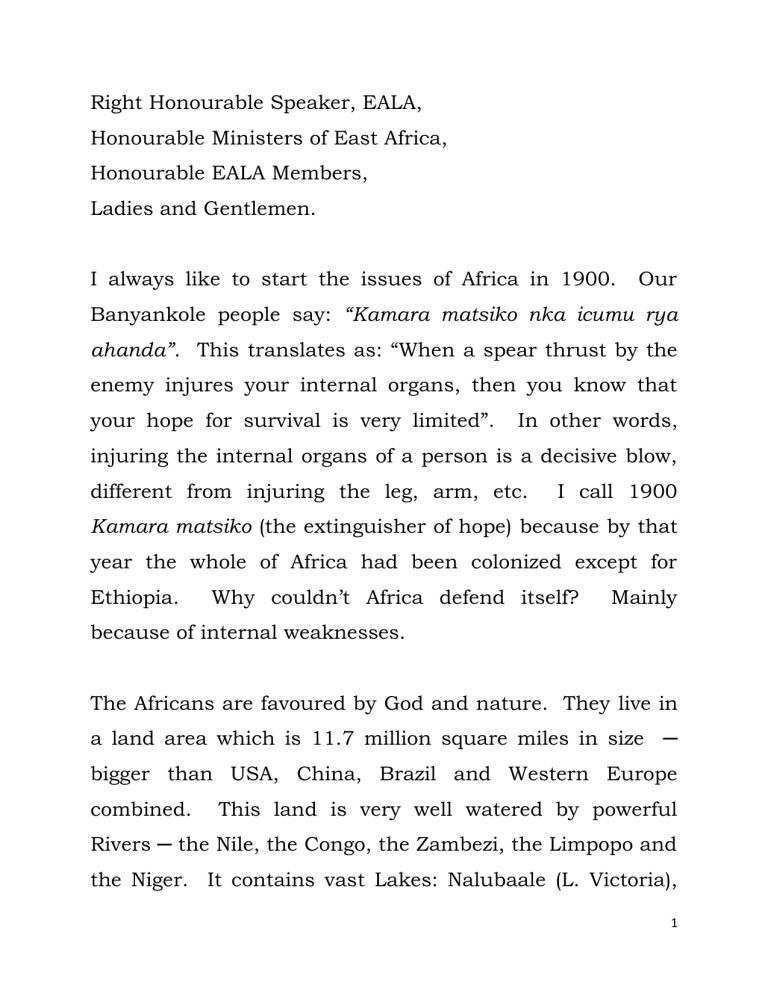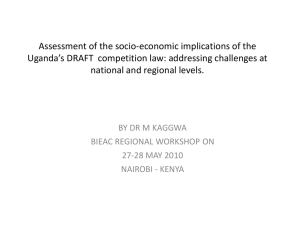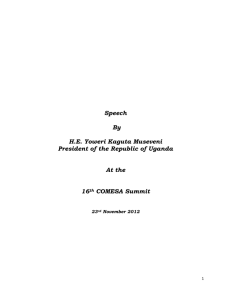Full Speech

Right Honourable Speaker, EALA,
Honourable Ministers of East Africa,
Honourable EALA Members,
Ladies and Gentlemen.
I always like to start the issues of Africa in 1900. Our
Banyankole people say: “Kamara matsiko nka icumu rya ahanda” . This translates as: “When a spear thrust by the enemy injures your internal organs, then you know that your hope for survival is very limited”. In other words, injuring the internal organs of a person is a decisive blow, different from injuring the leg, arm, etc. I call 1900
Kamara matsiko (the extinguisher of hope) because by that year the whole of Africa had been colonized except for
Ethiopia. Why couldn’t Africa defend itself? Mainly because of internal weaknesses.
The Africans are favoured by God and nature. They live in a land area which is 11.7 million square miles in size ─ bigger than USA, China, Brazil and Western Europe combined. This land is very well watered by powerful
Rivers ─ the Nile, the Congo, the Zambezi, the Limpopo and the Niger. It contains vast Lakes: Nalubaale (L. Victoria),
1
Rutshuru – Butumbi (L. Edward), Masyooro (L. George),
Kivu, Tanganyika, Nyasa, Turkana, etc. Africa’s 1 billion people are divided into just four linguistic groups: the
Niger-Congo (including the Bantu and the Kwa groups), the
Nilo-Saharan (including the Nilotic and Nilo-Hamitic dialects), the Afro-Asiatic (Arabic and Amharic) and the
Khoisan (so called bush men). Yet the reactionaries talk as if the African peoples are so divided that they cannot live together. Moreover, even the four linguistic groups mentioned above, are linked among one another. The
Somalis, for instance, call a cow: “Saa”.
The Banyankore,
Banyarwanda, Baganda, etc. use that word “saa” for cowdung ( busa, amasha , etc). Our Nilotic people call water
“Pii”.
The Somalis call water “Biyo”.
While the African peoples, therefore, are either similar or linked, the pre-colonial chiefs preferred to keep them divided into small tribal kingdoms, chiefdoms or segmentary societies and those divisions are still being promoted by the reactionaries today. This was definitely one of the causes for the colonization of Africa. Some people try to say that technology was the main cause for our colonization. I do not believe this. China and Japan
2
were backward technologically at that very time. The
Europeans tried to colonize them but failed. Even Ethiopia could not be conquered by the Europeans. Why? They were not easy to swallow because of a higher degree of political integration. Anyway, I always say that the defeat of the whole of Africa by 1900 was the ultimate vote of no confidence in the pre-colonial feudal systems of Africa.
Africa regained her freedom. Why? It was because of three factors: the resistance of the African peoples, the emergence of the Socialist Bloc (Soviet Union and China) in
1917 and 1949 respectively and the two inter-imperialist wars of 1914-18 and 1939-45 that weakened the imperialist countries to our advantage. We had also survived colonialism (unlike the Red-Indians, the Incas and the Aztecs of the Americas) because of our strong civilization that had involved quite advanced agriculture.
That is how we were able to survive the diseases brought by the Europeans and Arabs ─ smallpox, jiggers, etc. Our cattle, sheep, goats, chicken, etc. had inoculated us against those diseases that are called zoonotic diseases ─ diseases between man and animals. Therefore, the African peoples were and are quite advanced in civilization, language,
3
agriculture, technology (iron-working) and social organization but very weak in political organization ─ confining themselves to tribal, clan, etc. organization and, therefore, not taking full advantage of the similarities and linkages of the African peoples. After independence, the political leaders have also confined themselves to the colonial States ─ Uganda, etc. as if they were God made. If
Uganda is good, by giving each of our families a bigger market to sell our products and improve our welfare, why can’t East Africa be better? Political organization was weak in the pre-colonial times that is why we were colonized and it is still weak even now that is why we do not yet carry the commensurate weight Africa deserves.
Eventually, we regained our independence, with Ghana being the first in 1957. Unfortunately, on account of, again, exogenous (from outside) and endogenous (from inside) factors, 50 years after independence, most of the
African countries are still listed as LDCs (Least Developed
Countries). Today the middle income countries in Africa are 25.
4
There is not a single First World country in the whole length and breadth of Africa. Why? In the last 50 years in which I have been active in the resistance struggles in
Uganda and Africa either directly or indirectly, I have been, together with our colleagues, able to study the situation.
In these 50 years, I have identified 10 strategic bottlenecks which I would like to, again, mention here. These are:
1. Ideological disorientation whereby the reactionaries fragment the African Peoples into sectarianism of tribe, religion and gender chauvinism.
2. This ideological disorientation cannot allow the reactionaries to build viable and capable state pillars such as Army, Civil service, Judiciary, etc.
Consequently, any slight disturbance or challenge leads to the collapse of the State authority to the detriment of the People. Killings, raping, defilement, looting and all sorts of crime with impunity become the lot of the People.
3. Owing to inadequate analysis, attacks against the
Private Sector, including the physical expulsion of
5
elements of the entrepreneurial class as was done by the regime of Idi Amin. Even where there is no direct attack on the private sector, corruption, bribery, extortion and poor administration or regulation also hamper the thriving of the private sector.
Fundraisings by politicians and other groups e.g. churches and mosques, can also disrupt the growth of the private sector and the accumulation of capital. A poor savings culture on account of ostentatious consumption, drunkenness and other forms of social indiscipline also interfere with capital accumulation and, therefore, the strengthening of the Private Sector.
4. An under-developed human resource (society) on account of lack of education and lack of health care. A non-literate, non-skilled population does not fully realize its potential.
5. Inadequate infrastructure that causes the costs of doing business in our countries to go up, thereby undermining the profitability of companies operating in our countries.
6
6. Small internal markets on account of the excessive balkanization of Africa that cannot support large scale agricultural and industrials production. There was also neglect of developing export oriented industries apart from exporting unprocessed minerals and other raw-materials.
7. Lack of industrialization whereby we export unprocessed agricultural products and minerals, thereby losing money and jobs to the outsiders.
8. An under-developed services sector.
9. An under-developed agricultural sector.
10. Lack of Democracy.
The African countries, after a number of wasted decades, have started solving some of these strategic bottlenecks.
Democracy is now more wide-spread than in the 1960s and
1970s, for instance. Private sector – led growth is now accepted. Market integration started after the 1980 Lagos
Action Plan. In the case of East African Community (EAC),
7
it had started in 1948 with East African High Commission and Common Services Organization but broke down during
Amin’s time. We revived it in 1993. This is a good start in resolving this debilitating factor that undermines the profitability of businesses on account of the narrow markets that were caused by the balkanization of Africa.
On today’s occasion, I would like to talk on just two of the ten strategic bottlenecks I have mentioned above; the issue of small markets and inadequate development of infrastructure, especially electricity. The disorientation I mentioned above did not only apply to ideology. It also applied to even the concepts of development. The amount of opposition we have faced on the issue of increasing electricity generation is unbelievable and shameful.
Let me, however, start with the issue of small markets. I have already said that, at least, the African leaders, after
1980, started working on the issue of the regional trading blocs. That is how we got COMESA, Central African
Association and ECOWAS. EAC was already there as already pointed out; only that it broke down in 1977 until we revived it in 1993. SADC started off as the Frontline
8
States and the Liberation Movements that were fighting colonialism in Southern Africa in the 1960s, 70s and part of the 1980s until the emancipation of South Africa in
1994. Of all these blocs, the EAC is the one with the brightest future and with the greatest hope for Africa. EAC does not just aim at economic integration. It also aims at political integration through the formation of the East
African Federation. That is what article 5 (2) of the EAC
Treaty says. At some stage, we proposed to fast track this political integration. All the people of East Africa supported this and it was only in a few cases where there were some concerns about certain issues. This was very encouraging and laudable.
The case for the political federation is on account of the following points:
(i) Even if the economic integration is successful, there are very crucial issues that you cannot address. It is not easy, for instance, to address the issue of common
Defence when you are different countries. Yes, you can have collective Defence such as NATO’s case.
However, those Defence Pacts normally depend on one or so strong members such as the USA. Where is the
9
USA of Africa? A politically united EAC would provide the beginning of the USA of Africa which could provide the centre of gravity of Africa’s future. How have we insured Africa against future re-colonization and marginalization since Independence? When Africa confronted the moribund Portuguese colonialists and the racists in Southern Africa, we were supported with weapons by the Soviet Union and the People’s Republic of China. That is how we won military victories in
Mozambique (Samora Machel and Frelimo), in
Zimbabwe (ZANU–ZAPU), in Angola (MPLA), in Namibia
(SWAPO) and in South Africa (ANC). The socialist camps became part of the strategic rear of Africa with a clout that was respected and feared globally. What is our feared or respected strategic rear now? It is our duty to create this strategic rear when conditions are still favourable. It is inexcusable that we have squandered the last 50 years without doing so. Some global actors are trying to achieve military superiority on land, in the air, at sea and in space. Where does that leave Africa?
10
(ii) Fragmenting the hinterland from the sea coast is another big disadvantage created by the present balkanization and is fraught with potential problems.
(iii) Fragmenting the natural resources is another weakness. EAC has always had tremendous natural resources. New ones are being discovered. If these were under one political roof, our bargaining power in the world would be much greater. When we negotiate separately, there are even attempts at playing us against each other. You hear words like: “If you do not agree to these terms, your neighbours will leave you behind”. Of course, it is also easier to manage common resources better if we are under one political roof than when we are separate. I am talking about resources like lakes, rivers, etc.
(iv) Even economic integration per se is not easy when you are under separate political roofs. You have seen the problems in Europe recently. Owing to different levels of development, mere economic integration may benefit different countries unequally.
11
By being part of a common market, the consumers buy on equal terms a product produced anywhere in East Africa, quota free, tax free. At our present level of integration, we do not, however, share the taxes from the factory or share the jobs. This has potential for disenchantment with integration. When it is one political unit, even if there are inequalities, they are easy to handle because the jobs are equally accessible to all the citizens on merit and taxes are shared. When I had a retreat with Presidents Kibaki and
Mkapa in August, 2004, in Nairobi, we elaborated all the other reasons and they are in the document we issued at the end of that meeting. EALA and all the East Africans should push even more for the cause of the East African
Federation.
The issue of infrastructure, especially the electricity, shows how Africa got off the track even after Independence. As I repeatedly tell whatever African audiences I get chance to address, there is a Kwh per capita yardstick that is simply amazing. The USA has a Kwh per capita of 12,400. Some of the African countries have as low as 12!! Uganda had a
Kwh per capita of 30 in 1986. We now have a Kwh per capita of 150. When Karuma, Ayago, Isimba, the mini-
12
hydro stations that are about to be embarked on and the geo-thermal project of Lake Katwe are finished, we shall have a Kwh per capita of 400. This is, like in about five years time. There is some awakening now in Uganda after repeated quarrels with the persons concerned. As of now, only South Africa and Libya have a Kwh per capita of 4,000 and above. Uganda aims at 42,000 MW by 2040. Africa and EAC needs a general awakening on this issue. We should not be diverted again.
In conclusion, I am glad that most of the strategic bottlenecks have been identified and are being addressed.
Uganda will become a lower middle income country by
2017 and an upper middle income by 2032 or earlier. At last, after endless internal struggles, this vision, with the correct understanding of the strategic bottlenecks, has been incorporated into the 5 years and 10 years plans by the National Planning Authority (NPA). We are now moving having wandered in the wilderness of “ideological and conceptual confusion” for some time.
By identifying some of these bottlenecks, much of Africa is beginning to move. The average rate of growth has doubled
13
to 5.44% per annum since the year 2000 compared to a growth rate of 2.5% in the 1990s. When EAC gets closer together, the sky is the limit especially now when we have discovered the gaps that crippled us in the past. There are, of course, other tactical bottlenecks such as corruption, administrative delays etc. These are, however, easier to deal with when you have dealt with the strategic bottlenecks.
Long Live EAC.
I thank you.
Yoweri Kaguta Museveni
PRESIDENT OF THE REPUBLIC OF UGANDA
24 th April, 2013 Kigali
14









